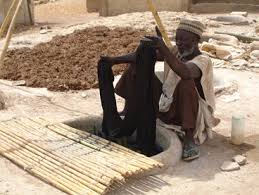 |
| photo from adireafricantextiles.com |
Africa also has a long and rich history of producing indigo for its commercial and cultural markets. Ironically Africa, like India also used slave labor to support its indigo industry. Africa's slave labor actually increased as trans-Atlantic slave exports decreased. During 1905 in response to their harsh treatment and expanding demand for indigo textiles, slaves revolted, deserting their masters to start their own dying shops. West Africa became known for its beautiful indigo fabrics and was frequented by European merchants who conducted a thriving trade with the dying business now run by women.
 |
| photo from pinterest.com |
Africal like other the countries that grew indigo believed that it also had strong medicinal properties. Indigo was thought to aid in treating bites from insects, snakes, and animals as well as fever, stomach maladies, and aiding in childbirth. A mixture of indigo and beeswax was wrapped around a wound to stop an infection. Guatemalan farmers treated their animals with indigo to control mites. Even as late as the 1980's women in remote Arabian villages still anointed themselves and their children with indigo believing in its protective qualities.
No comments:
Post a Comment